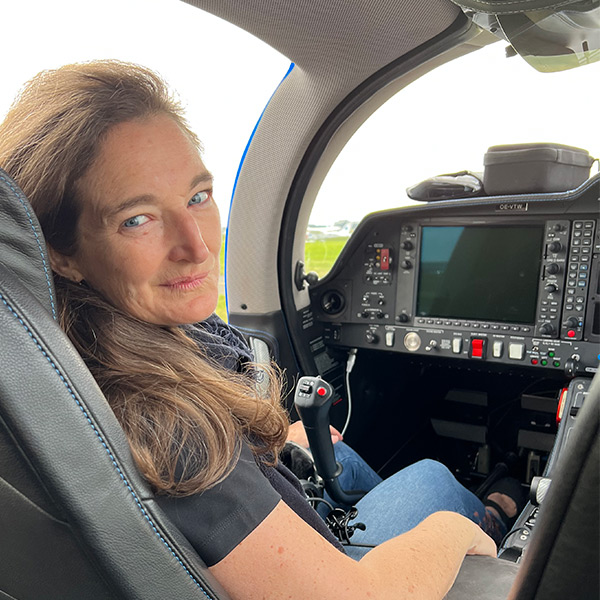The Pilot Logbook retails for $7.95. For more information, contact Gleim Publications Inc., Post Office Box 12848 University Station, Gainesville, Florida 32604; telephone 800/874-5346 or 352/375-0772; fax 888/375-6940; or visit the Web site ( www.gleim.com ).
UltraFlite Headset
Fifteen years ago, pilots had two options when it came to protecting their hearing: headsets or earplugs. Now, among the dizzying array of passive and active noise reduction (ANR) headsets on the market comes a new product that is, yes, a hybrid of a headset and a set of earplugs.
UltraFlite marries a lightweight headband with a boom mic to what appears to be a set of earplugs attached to thin, clear tubing. The foam earplugs are sized to snugly fit 90 percent of pilots' ear canals, as the tubing delivers sound directly into the ears. The result? A setup that Quiet Technologies, maker of UltraFlite, claims to reduce noise levels by the same amount that most ANR headsets do.
We tested the UltraFlite headset on cross-country flights in a Piper Archer. The smaller earplugs were used, placed deep in the canal to properly block incoming sound waves. The deadening of sound was, well, like wearing earplugs. However, audio from the aircraft's communications and intercom systems was clearly heard through the plugs. The headset rested comfortably on the user's head, and the adjustable boom mic carried sound relatively well - one unicom operator pronounced it "a little muffled," but other communications with ATC were pronounced loud and clear.
In practice, the UltraFlite set reduced cockpit noise to levels better than the passive headset we subjectively measured it against, and almost as well as the new ANR set we used. Company literature claims equal noise reduction to ANR sets by virtue of attenuation data at a wide range of frequencies (125 to 8,000 Hz). Because the ear cups associated with passive and ANR sets contribute only 9 dB of noise reduction at the 125 Hz level, and the ear inserts used on the UltraFlite headset offer 29.7 dB at that frequency, the low throb that ANR serves to cancel (with an additional 26 dB of noise reduction in high-end headsets) is effectively reduced by these pieces of foam. It should be noted that the tubing used to pipe in audio through the ear inserts reduces the noise reduction slightly, so the ultimate noise reduction UltraFlite offers at 125 Hz, for example, is around 20 to 25 dB.
An equal benefit is the headset's incredible light weight. The UltraFlite headset only weighs 1.25 ounces (the audio box and mic jacks add 2.5 ounces). Compared to the 15 to 30 ounces of typical passive and ANR headsets, that's not much. When multiplied over a long flight, the fatigue factor is definitely reduced.
An upcoming version of UltraFlite, called MicroFlite, will have a custom-molded earpiece and boom mic that fits neatly over one ear and weighs less than a half-ounce. UltraFlite retails for $325; the MicroFlite headset is expected to retail for less. For more information, contact Quiet Technologies at 866/784-3883; or visit the Web site ( www.quiettechnologies.com ).
Handling In-Flight Emergencies
Another installment of the Practical Flying Series from McGraw-Hill addresses what a pilot can do to cope with emergency situations. Written by flight instructor and aviation attorney Jerry Eichenberger, Handling In-Flight Emergencies teaches you to defuse problems before they blossom into emergencies.
For example, the section on engine failure discusses fuel management first: fuel starvation, where the fuel supply is cut off, or fuel exhaustion, where the fuel supply runs out, are the leading causes of engine failure - not some mechanical mystery. After a thorough dissertation on fuel, Eichenberger then goes into the things that can go wrong with the engine itself. But this gives just one example of how a lack of planning - or a lack of systems knowledge in the case of fuel starvation - is more likely to cause a problem than the airplane itself.
Pilots learn preferred ways of coping with icing, severe weather, high surface winds, instrument conditions, spatial disorientation, and navigational errors. Real-life case studies illustrate each situation.
Handling In-Flight Emergencies retails for $34.95 and covers 300 pages. The book is available at many large bookstores or online booksellers. For more information, contact McGraw-Hill via the Web site ( www.books.mcgraw-hill.com ).
Briefly Noted
Say Again, Please: Guide to Radio Communications, by Bob Gardner, is now available in its second edition from ASA. Understanding air traffic control and overcoming inhibitions about talking on the radio are among a student pilot's greatest challenges. Gardner includes material on using global positioning system (GPS), land-and-hold-short operations (LAHSO), and current rules and operating procedures. A full-color sectional excerpt allows students to review the chart while reading the explanations for flying and talking in each area. The book retails for $19.95.
Also from ASA, The Pilot's Manual Series: Volume One, Flight School covers all tasks from the private and commercial practical test standards. More than 500 full-color illustrations illuminate the topics, and an airplane checkout review is included in the appendix. With a foreword by AOPA Pilot columnist Barry Schiff, the third edition of Flight School is designed to give readers all they need to prepare for FAA knowledge exams and checkrides. Retail price for the book is $49.95. For more information, contact Aviation Supplies and Academics, 7005 132nd Place Southeast, Newcastle, Washington 98059-3153; telephone 800/426-8338 or 425/235-1500; fax 425/235-0128; or visit the Web site ( www.asa2fly.com ).
Above It All Aviation recently released its latest installment of F.A.S.T. Flashcards for those pursuing a private pilot certificate. The cards are color-coded by topic and ask open-ended questions easily tailored to your aircraft and operations. Topics covered include those on both the knowledge and oral exams and help the applicant prepare for the practical test. The set retails for $31.95. For more information, contact Above It All Aviation via the Web site ( www.fastflashcards.com ).

